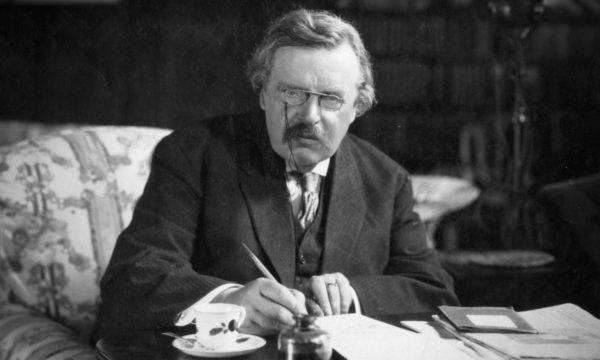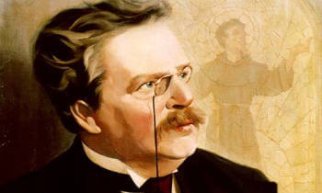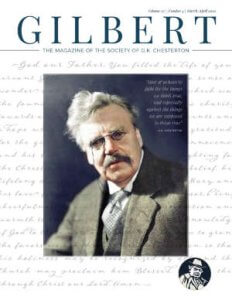A poem is picture painted with words. If a picture is worth a thousand words, so is a poem, even if the poem has very few words. A poem uses language as a shortcut to an idea or a feeling that would take much longer to describe in prose. A short poem can sometimes say much more than an entire book can. This is why even someone who is master of prose, someone such as G.K. Chesterton, abandons prose and turns to poetry to express something too deep for mere words: the mysteries that surround the Virgin Mary. Chesterton uses poetry for the same reason that hundreds of painters have used paint. And hundreds of sculptors have used wood and marble. And hundreds of composers have used music. For the same reason that Mary has been the subject of Christian art for centuries. The fact that Mary appeals to the greatest artists is by itself evidence of her penetrating and enduring greatness. That she also appeals to the lowliest and most anonymous folk artists and simple people also speaks of her universal appeal. Chesterton says that the Hottentots did not try to paint Mumbo Jumbo as Raphael painted Madonnas. There is nothing in any other religion to compare with it. Artists have indeed been obsessed with her because they are trying to express some inexpressible truth about the woman who gave birth to God.
Just as a poem or a painting is a shortcut to an idea, Mary is a kind of shortcut to the greatest of all ideas: the love of God. Ultimately, that is what creativity is all about. Ultimately, that is what all artists are always trying to accomplish for us: the legitimate short cuts to the love of God. And that explains why artists are drawn to the Mother of God as a subject.
The Queen of Seven Swords is a slim volume of poems that Chesterton published in 1926. The title is a reference to the second chapter of Luke’s Gospel. When Mary and Joseph presented the baby Jesus at the Temple, Simeon rejoiced that his eyes had seen God’s salvation (which is what the name Jesus means), but he prophesied that the child would be a sign of contradiction. Then he looked at Mary and said to her: “And thy own soul a sword shall pierce, that, out of many hearts thoughts may be revealed.” (Luke 2:34)
Chesterton refers to a “seven-fold splendour” surrounding Mary, corresponding to the seven wounds of Christ, and there are seven poems in this collection corresponding to the seven champions of Christendom. And in the poem, “The Towers of Time,” Chesterton writes
…the heart of the swords, seven times wounded,
Was never wearied as our hearts are.
Mary is a springboard to mysticism because she shares the sufferings of Christ, and meditating on Mary’s sufferings draws one mystically into Christ’s sufferings. “Out of many hearts thoughts may be revealed.” The cross is indeed the sign of contradiction. It is the eternal paradox. It is the center of Chesterton’s thought, and it is not without significance that the cross and the sword have the same shape. In these poems, Chesterton reveals his swordsmanship with the pen. The sword is an image that cuts both ways. It is, of course, the weapon that wounds, but it is also the weapon that defends; it is the symbol of chivalry, of knighthood. Deep calls to deep. Paradox answers paradox.
In the poem called “A Little Litany,” Chesterton paints a word picture of the Madonna and child, with the baby Jesus crawling up from his mother’s lap, and looking her in the eye…
[He] found his mirror there; the only glass
That would not break with that unbearable light
Till in a corner of the high dark house
God looked on God, as ghosts meet in the night.
Can we find in all of literature a more profound and provocative image than God looking at God in the reflection of his mother’s eye? The marvelous images go on for ever. That is why there are thousands of different Madonnas throughout the history of art, and why Chesterton says in another of poem, “In all thy thousand images we salute thee,” and why in another poem he muses that if all the statues of Mary were smashed, we would still carve her image with a song. It is an inexhaustible profundity.
These wells that shine and seem as shallow as pools,
These tales that, being too plain for the fool’s eyes,
Incredibly clear are clearly incredible.
Truths by their depth deceiving more than lies.
There is another paradox for you. The story of the Virgin Mother of God is a deep well that looks like a shallow pool. A simple story hugely complex. A truth more deceiving than a lie. One of the reasons for the Protestant dislike of Catholic art, besides the completely false charge of idolatry, was simply the Puritanical dislike for anything beautiful. But Chesterton suggests that there is something even more sinister about the attack on Mary. In the poem, “A Party Question,” Chesterton actually treats the original Protestant revolt against the Catholic Church very sympathetically, acknowledging full well that the Church was indeed corrupt with “Bad men who had no right to their right reason” who were opposed by “Good men who had good reason to be wrong.” But as that “tangled war” continued, it became more devious. The goal was no longer reform of the Church. It became the destruction of the Church. The revolt had lost its innocent anger. It simply started to attack everything about the Catholic Church. When it attacked the Mother of God, Chesterton said the sound was recognizable. It was “a hiss out of hell.”
The Protestant revolt fizzled into rudderless skepticism. The result is the agnostic age we live in, tortured by apathy and relativism and self-centeredness. We are in the new dark ages. We need the same light of faith that led us out of the previous dark ages. We need a return to honor, to chivalry.
Where shall they go that have delight in honour
When all men honour nothing but delight?
We need – and we are seeing – a resurgence in the devotion to the Virgin Mary. It is the only cure for a society that kills its own children. In the prophetic poem, “An Agreement,” Chesterton turns to the world and says it is our “sterile appetites” that scorn the “creative purity” of Mary.
So: in her house Life without Lust was born,
So in your house Lust without Life shall die.





